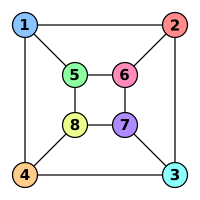
Photo from wikipedia
This paper presents, HitGraph, an FPGA framework to accelerate graph processing based on the edge-centric paradigm. HitGraph takes in an edge-centric graph algorithm and hardware resource constraints, determines design parameters… Click to show full abstract
This paper presents, HitGraph, an FPGA framework to accelerate graph processing based on the edge-centric paradigm. HitGraph takes in an edge-centric graph algorithm and hardware resource constraints, determines design parameters and then generates a Register Transfer Level (RTL) FPGA design. This makes accelerator design for various graph analytics transparent and user-friendly by masking internal details of the accelerator design process. HitGraph enables increased data reuse and parallelism through novel algorithmic optimizations, including (1) an optimized data layout that reduces non-sequential external memory accesses, (2) an efficient update merging and filtering scheme to reduce the data communication between the FPGA and external memory, and (3) a partition skipping scheme to reduce redundant edge traversals for non-stationary graph algorithms. Based on our design methodology, we accelerate Sparse Matrix Vector Multiplication (SpMV), PageRank (PR), Single Source Shortest Path (SSSP), and Weakly Connected Component (WCC). Experimental results show that HitGraph sustains a high throughput of 2076 Million Traversed Edges Per Second (MTEPS) for SpMV, 2225 MTEPS for PR, 2916 MTEPS for SSSP, and 3493 MTEPS for WCC, respectively. Compared with highly-optimized multi-core implementations, HitGraph achieves up to 37.9× speedup. Compared with state-of-the-art FPGA frameworks, HitGraph achieves up to 50.7× throughput improvement.
Journal Title: IEEE Transactions on Parallel and Distributed Systems
Year Published: 2019
Link to full text (if available)
Share on Social Media: Sign Up to like & get
recommendations!